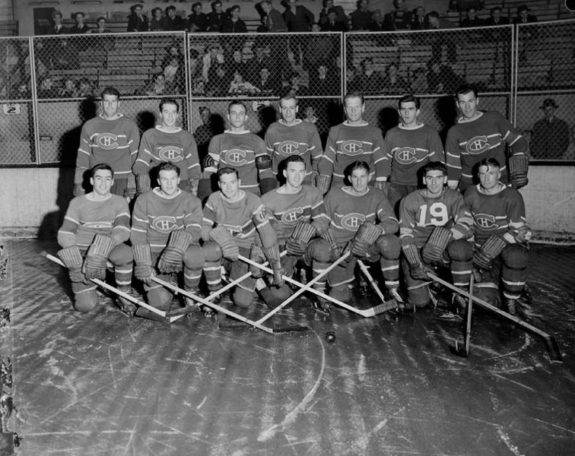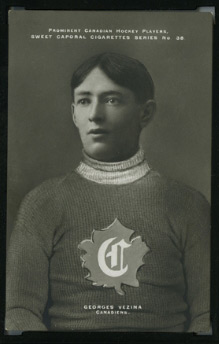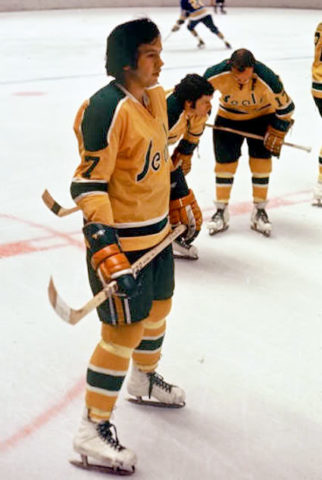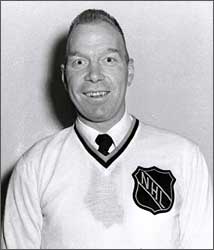Have you ever wondered why referees wear striped shirts, or teams have to wear contrasting colours? Then this is for you.
Contrasting Colours in NHL Uniforms
Hockey uniforms were very simple in the early days. Since most players also played football in the summertime, they simply borrowed these pants for hockey games, then added a turtleneck sweater to stay warm along with some knee high socks. With only a combined total of fourteen players involved there was little need for decidedly differing uniforms, it was easy for players to know who played for who.
This began to change as teams of various leagues began to play each other, and they often wore the same uniform, as in the 1920 Stanley Cup Final when the PCuHL champions from Seattle had similar uniforms to Ottawa. Ottawa decided to wear white jerseys and the problem was solved. In 1933, the Detroit Red Wings chose the colour of their new uniforms and they were the same as the Montreal Canadiens. When the teams first met in Montreal, in order to tell them apart, the Wings were forced to wear white covers – like in a modern gym class. They covered up the player’s numbers angering the fans in attendance, in addition to looking stupid. Thus began the debate about the colours used by teams during games.
In the 1940s, some teams had begun voluntarily to wear contrasting colours (including Montreal’s now odd-looking original white uniform), but at the NHL meetings in 1950 the use of contrasting uniforms became mandatory. The reason was due to the increasing number of motion picture newsreels being made of the action (which would soon become black and white television), that the NHL required each team should wear contrasting colours to make it easier for viewers to distinguish the teams during the black and white broadcasts.

The home team would wear dark, the visitor white. It was Hockey Night In Canada that suggested that the NHL switch in 1970 to the home team wearing white jerseys in order to show off visiting team’s away jerseys (which were deemed more interesting) for colour broadcasts. Which team wears the dark jerseys has changed back and forth in the forty years since, with currently the home team now wearing the dark.
NHL Uniforms Numbering Players
The Patrick brothers have always been credited with devising the numbering of players for the PCHL in 1915, but this is false. The NHA first adopted this practice in 1911 with a rule stating “players had to wear identifying numbers on armbands placed on their left arm.” When these were deemed unsatisfactory, large numbers were placed on the front of the sweater, and a board with the player and number placed at one end of the rink. Eventually numbers would be moved to the back of the jersey, and the board replaced by individual programs. In 1954, the NHL requested that player’s numbers be painted in white on the boot of their skates. This was to help recognition of players for the awarding of assists and in television or photos where the uniform numbers were not visible. This only lasted for a few years.
In 1977-78, the NHL passed a new rule stating that players had to have their names appear on their jerseys along with their numbers. Leaf owner, Harold Ballard refused, claiming no one would then buy his programs. The league threatened heavy fines, so Ballard gave in. For Toronto’s next game in Chicago on February 26, 1978, the names appeared on the Leaf’s blue jerseys….in blue, making them unreadable. The next day the league changed the wording of the rule, to stipulate the names must be in a colour opposite to the colour of the jersey. The Leafs then began using a contrasting colour as the rest of the league.
Montreal Canadiens NHL Uniforms

The Montreal Canadiens are the most recognizable hockey team in the NHL with their red, white, and blue sweaters with the ‘Ch’ on the front. However, the first Montreal jersey on their inception in 1910 was a solid blue colour with a white crescent ‘C’ on the front. They did not change to red, white and blue until the following year, but their sweaters were still not the familiar ones. This uniform had striped lines similar to the barber poles of the Ottawa Senators, and had the blue letters ‘CAC’ (Club Athletique Canadien) on a white maple leaf. Thus, Montreal not Toronto was the first NHA/NHL team to wear a maple leaf on their sweaters.
When Montreal finally changed to the more familiar jersey, they did not play with their familiar ‘CH’ on the chest but ‘CA’ (which was changed the next season). After winning the Stanley Cup in 1924, the Canadiens returned for the 1924-25 season without the ‘CH’ but instead had an earth globe on their chest to signify that they were the World Champions. By 1925-26, the distinctive uniform we have come to know was finalized.
Hockey and NHL Uniforms’ Oddities
In Nova Scotia, the Windsor Swastikas used the ancient symbol of good luck on their sweaters. They won several championships during the 1910’s. With the symbol’s new use in Nazi Germany in 1933, the team decided to change the emblem. The Toronto 228th battalion, a team of hockey players in the army, appeared for the 1917 season in khaki jerseys. Needless to say, the choice of colour was not a big hit with the fans.
On St. Patrick’s Day, 1934, King Clancy was honored with a special night in Toronto. After many gifts were presented, Clancy arrived seated on a throne atop a large float. He played the game against the New York Rangers wearing a green uniform with a large shamrock on the back. Lester Patrick asked Clancy to change back to his regular uniform after the first period, as the green sweater was confusing to the Rangers. It is the only time in the NHL that a player has worn a jersey different from every other player on the ice.
The New York Rangers felt that their sweaters were the cause of their bad performance in the 1940’s. They changed the familiar uniform that they still wear for one year in 1946, adding a number to the front of the jersey. When they again missed the playoffs, they went back to the familiar uniform. The Philadelphia Flyers wanted to start a trend by having the defending Stanley Cup champions wear a small Stanley Cup patch on their jersey in 1974-75. The NHL was not thrilled by the idea, and the Flyers used it for a few games before discarding them.

There have been some poor NHL uniforms choices in the last forty years. In 1970 Charles Finley, owner of baseball’s A’s, bought the California Golden Seals. He so liked the white shoes worn by the baseball players that he wanted his hockey players in white skates. Unfortunately this gave the players the impression of wearing women’s figure skates, which was not a good confidence boost for the already low-physical Seals. Players also suggested that something about the white skates retained more water than normal skates, making them extremely heavy by the third period, actually slowing the players down. They were only used for a season.
The early 80’s saw two abominations. The Philadelphia Flyers and the Hartford Whalers changed to the new Cooperalls (or rather CCM Pro Pak long shells, according to Mr. Pichette – thanks) that were coming into fashion in amateur hockey. Also, the Vancouver Canucks who had worn ugly blue-green uniforms since their entrance to the league decided to change NHL uniforms. Most felt that this was a good idea until the replacements were shown. The new jerseys resembled a mustard stain. I’m not sure which was worse, Tiger Williams looking like he just ate a hot dog or the sight of Bobby Clarke and Darryl Sittler in long pants.
Referee NHL Uniforms
Officials have worn many different uniforms in the course of hockey’s history. Pre-NHL era officials wore suits and Derby hats, while Mike Grant wore a hard-hat in the rough 1905 Stanley Cup Series between Kenora and Ottawa. In the early NHL days, referees usually wore black pants with a white sweater and a tie. This look could still be worn by referees in recent NCAA U.S. College hockey and in a few NHL outdoor games. For a while the referee’s assistant wore a blue jersey in the 1930’s. In the late 1940’s, the NHL changed their officials from the white sweaters to orange shirts. They would wear these shirts until December 29, 1955.

On December 29, for a game between Toronto and Montreal, the referee’s new NHL uniforms caused heads to turn. With the advent of televised hockey (which was black and white) too many viewers complained that the referees were mistaken for members of the home team (who wore dark jerseys). The NHL began this night to place their referees in black and white vertically striped shirts in order to distinguish them from the players. The striped shirt for referees seems to have its origin in US college football in the 1920’s, but I can find no reference of this uniform used by any major hockey league until 1955. In 1969-70, the NHL adopted orange armbands for the referees, adopted out of the fact the previous jersey colour was orange. The modern uniform had been born. NHL referees have since always worn the vertical stripes, except for one playoff game in 1988, the famed “doughnut gate” between the Devils and Bruins. (A good look at referee sweaters through the years can be found at Third String Goalie)
(Source material used for this article includes- Charles L Coleman, Trail for the Stanley Cup volume 1-3; Claude Mouton The Montreal Canadiens; Scott Young, The Boys of Saturday Night; Garth Vaughan, The Puck Starts Here; Dan Diamond The Spirit of the Game, Red Storey image from the HHoF)

I would trust you are familiar with this site: http://www.nhluniforms.com